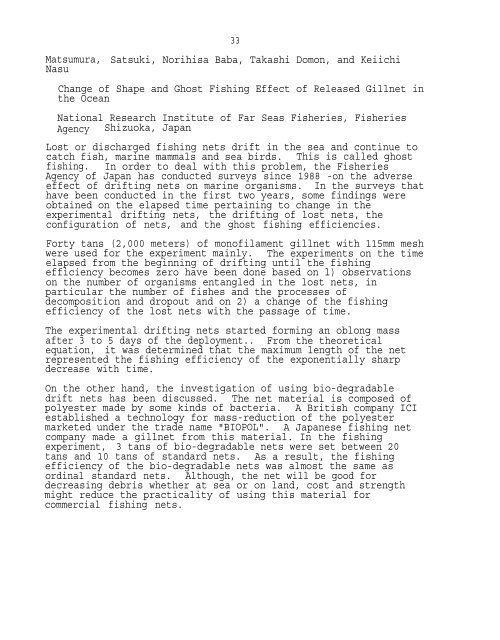Poster abstracts and manuscripts from the Third International ...
Poster abstracts and manuscripts from the Third International ...
Poster abstracts and manuscripts from the Third International ...
You also want an ePaper? Increase the reach of your titles
YUMPU automatically turns print PDFs into web optimized ePapers that Google loves.
Matsumura, Satsuki, Norihisa Baba, Takashi Domon, <strong>and</strong> Keiichi<br />
Nasu<br />
33<br />
Change of Shape <strong>and</strong> Ghost Fishing Effect of Released Gillnet in<br />
<strong>the</strong> Ocean<br />
National Research Institute of Far Seas Fisheries, Fisheries<br />
Agency Shizuoka, Japan<br />
Lost or discharged fishing nets drift in <strong>the</strong> sea <strong>and</strong> continue to<br />
catch fish, marine mammals <strong>and</strong> sea birds. This is called ghost<br />
fishing. In order to deal with this problem, <strong>the</strong> Fisheries<br />
Agency of Japan has conducted surveys since 1988 -on <strong>the</strong> adverse<br />
effect of drifting nets on marine organisms. In <strong>the</strong> surveys that<br />
have been conducted in <strong>the</strong> first two years, some findings were<br />
obtained on <strong>the</strong> elapsed time pertaining to change in <strong>the</strong><br />
experimental drifting nets, <strong>the</strong> drifting of lost nets, <strong>the</strong><br />
configuration of nets, <strong>and</strong> <strong>the</strong> ghost fishing efficiencies.<br />
Forty tans (2,000 meters) of monofilament gillnet with 115mm mesh<br />
were used for <strong>the</strong> experiment mainly. The experiments on <strong>the</strong> time<br />
elapsed <strong>from</strong> <strong>the</strong> beginning of drifting until <strong>the</strong> fishing<br />
efficiency becomes zero have been done based on l) observations<br />
on <strong>the</strong> number of organisms entangled in <strong>the</strong> lost nets, in<br />
particular <strong>the</strong> number of fishes <strong>and</strong> <strong>the</strong> processes of<br />
decomposition <strong>and</strong> dropout <strong>and</strong> on 2) a change of <strong>the</strong> fishing<br />
efficiency of <strong>the</strong> lost nets with <strong>the</strong> passage of time.<br />
The experimental drifting nets started forming an oblong mass<br />
after 3 to 5 days of <strong>the</strong> deployment.. From <strong>the</strong> <strong>the</strong>oretical<br />
equation, it was determined that <strong>the</strong> maximum length of <strong>the</strong> net<br />
represented <strong>the</strong> fishing efficiency of <strong>the</strong> exponentially sharp<br />
decrease with time.<br />
On <strong>the</strong> o<strong>the</strong>r h<strong>and</strong>, <strong>the</strong> investigation of using bio-degradable<br />
drift nets has been discussed. The net material is composed of<br />
polyester made by some kinds of bacteria. A British company ICI<br />
established a technology for mass-reduction of <strong>the</strong> polyester<br />
marketed under <strong>the</strong> trade name "BIOPOL". A Japanese fishing net<br />
company made a gillnet <strong>from</strong> this material. In <strong>the</strong> fishing<br />
experiment, 3 tans of bio-degradable nets were set between 20<br />
tans <strong>and</strong> 10 tans of st<strong>and</strong>ard nets. As a result, <strong>the</strong> fishing<br />
efficiency of <strong>the</strong> bio-degradable nets was almost <strong>the</strong> same as<br />
ordinal st<strong>and</strong>ard nets. Although, <strong>the</strong> net will be good for<br />
decreasing debris whe<strong>the</strong>r at sea or on l<strong>and</strong>, cost <strong>and</strong> strength<br />
might reduce <strong>the</strong> practicality of using this material for<br />
commercial fishing nets.
















